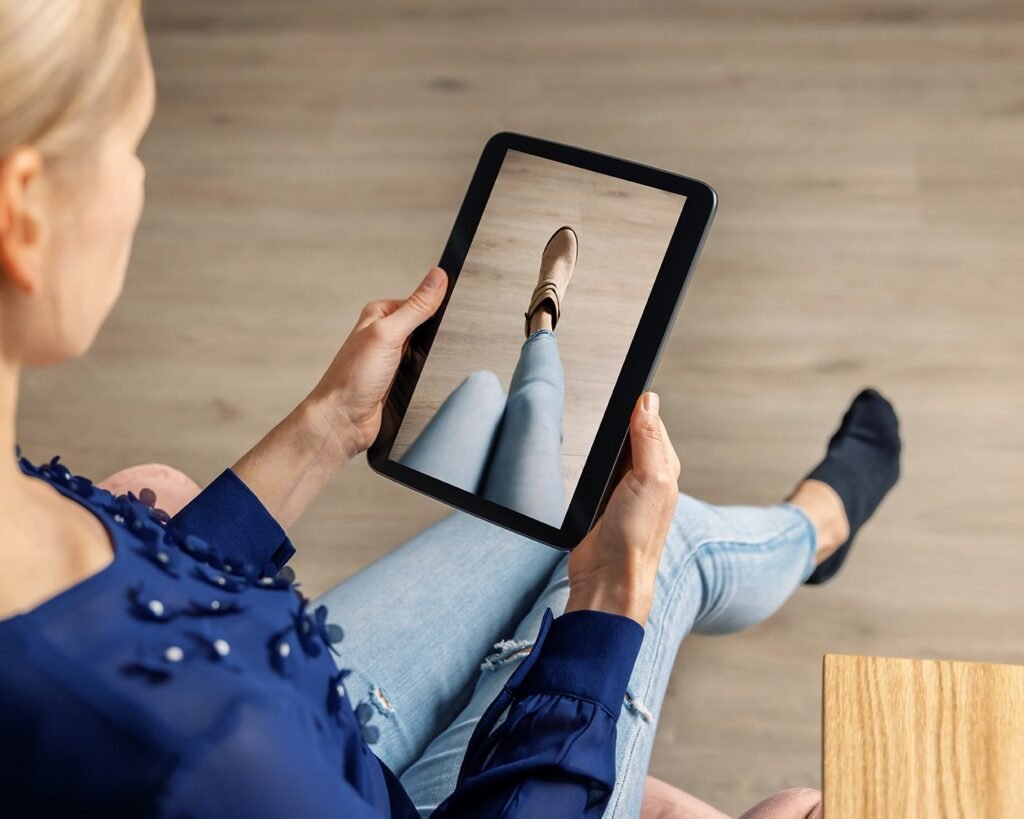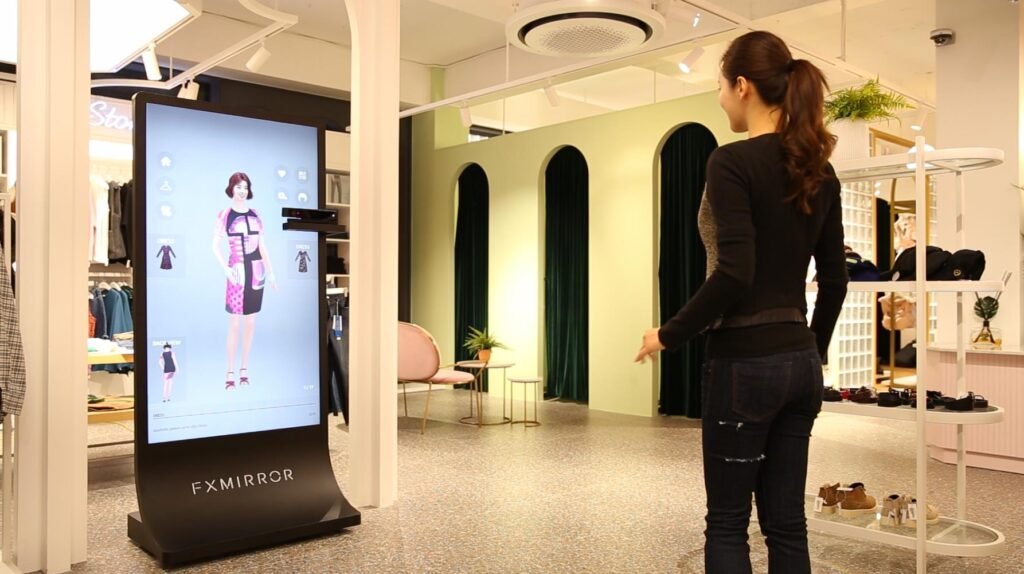The Impact of Technology on Fashion has had a profound impact on the fashion industry, influencing everything from design and manufacturing to marketing and consumer behavior. Here are some key areas where technology has made a significant impact:

1. Design and Creativity
- Digital Design Tools: Software like Adobe Illustrator and CLO 3D allows designers to create and visualize garments in intricate detail before production. 3D modeling and virtual prototyping have revolutionized the design process, enabling designers to experiment with patterns and fabrics without the need for physical samples.
- AI and Machine Learning: AI algorithms can analyze fashion trends, predict future trends, and even help in the design process by suggesting color palettes and patterns based on current data.
2. Manufacturing and Production
- Automation: Advances in automation and robotics have streamlined the manufacturing process. Automated cutting machines and sewing robots have increased efficiency and precision in garment production.
- 3D Printing: This technology allows for the creation of intricate designs and custom pieces. Designers are experimenting with 3D-printed accessories and even entire garments.
3. Sustainability
- Eco-Friendly Materials: The Impact of Technology on Fashion has enabled the development of sustainable materials, such as fabric made from recycled plastics or organic fibers. Innovations in textile production are helping reduce waste and environmental impact.
- Smart Manufacturing: The Impact of Technology on Fashion: Blockchain and IoT are being used to improve supply chain transparency, trace the origin of materials, and ensure ethical practices in the fashion industry.

4. Retail and E-Commerce
- Virtual Try-Ons: Augmented reality (AR) and virtual reality (VR) technologies allow customers to try on clothes virtually, enhancing the online shopping experience and reducing the need for returns.
- Personalization: Data analytics and AI are used to create personalized shopping experiences, from tailored recommendations to customized clothing options.
5. Marketing and Engagement
- Social Media: Platforms like Instagram, TikTok, and Pinterest have become crucial for fashion marketing, enabling brands to engage with consumers directly and leverage influencer partnerships.
- Digital Fashion Shows: Virtual fashion shows and digital presentations have become more common, allowing brands to reach global audiences without the logistical challenges of traditional runway shows.
| Aspect | Virtual Fitting Rooms | AI Trends |
| Technology Used | Augmented Reality (AR), Virtual Reality (VR), and 3D modeling | Machine Learning, AI Algorithms, Predictive Analytics, and Design |
| Primary Function | Allows users to virtually try on clothes using their device’s camera or a virtual avatar | Analyzes data for trend forecasting, assists in design creation, and improves customer interaction |
| Customer Experience | Enhances online shopping by helping customers visualize how clothes will fit and look | Personalizes recommendations, provides styling advice, and customizes shopping experiences |
| Impact on Returns | Reduces return rates by allowing customers to better understand fit and appearance before purchase | Indirect impact by improving accuracy in recommendations and designs |
| Personalization | Virtual fitting rooms can suggest items based on previous attempts and user preferences | AI offers tailored recommendations and personalized styling based on data and user behavior |
| Sales Conversion | Higher conversion rates as customers are more confident in their purchases | Increases sales through targeted marketing and personalized product suggestions |
| Design Innovation | There is limited direct impact, but AR and VR can be used for virtual fashion shows and presentations | AI helps generate new design ideas, patterns, and color schemes based on trend analysis |

6. Consumer Experience
- Smart Clothing: Wearable technology, such as smart textiles that can track health metrics or change color, is becoming more prevalent. These innovations merge fashion with functionality, offering new possibilities for personal expression and utility.
- Enhanced Shopping Experiences: Technology enhances the in-store experience with features like interactive mirrors and smart fitting rooms, providing a more immersive and convenient shopping journey.
In summary, The Impact of Technology on Fashion continues to reshape the fashion industry in numerous ways, driving innovation and efficiency while also offering new opportunities for creativity and consumer engagement.
The Impact of Technology on Fashion: Virtual Fitting Rooms and AI TrendsChatGPT
The Impact of Technology on Fashion have significantly impacted the fashion industry by enhancing the shopping experience and revolutionizing how brands approach design and consumer interaction. Here’s a closer look at these technologies and their implications:

7. Virtual Fitting Rooms
**1. Enhanced Shopping Experience:
- Try-Before-You-Buy: The Impact of Technology on Fashion use augmented reality (AR) to allow customers to try on clothes virtually. This technology helps shoppers visualize how garments will look on their body type without physically trying them on, which can be especially useful for online shopping.
- Reducing Returns: By allowing customers to see how items fit and look in a virtual setting, virtual fitting rooms can reduce the number of returns due to sizing or style issues, leading to a more sustainable and cost-effective retail process.
**2. Personalization:
- Tailored Recommendations: Virtual fitting rooms can integrate with AI algorithms to offer personalized styling recommendations based on the user’s preferences, body measurements, and previous purchases.
- Virtual Stylists: Some platforms offer virtual stylists that use AI to suggest outfits or combinations, enhancing the shopping experience by providing curated options that suit individual tastes.
**3. Accessibility and Convenience:
- Anytime, Anywhere: Shoppers can access virtual fitting rooms from their homes or on-the-go, making the shopping experience more flexible and convenient.
- Inclusivity: Virtual fitting rooms can cater to a wider range of body types and sizes, promoting inclusivity by allowing users to see how various styles might fit them.
8. AI Trends in Fashion
**1. Trend Prediction:
- Data Analysis: AI can analyze vast amounts of data from social media, fashion shows, and other sources to predict emerging trends. This helps designers and brands stay ahead of the curve and create collections that resonate with current consumer preferences.
- Consumer Insights: AI algorithms can analyze consumer behavior and feedback to identify trends and preferences, enabling brands to make data-driven decisions.
**2. Design Innovation:
- Generative Design: AI can assist in the creative process by generating new design ideas or patterns based on input from designers. This can lead to innovative and unique fashion creations that might not have been conceived through traditional methods.
- Custom Design: AI-powered tools can allow consumers to design their own clothes or customize existing designs, offering a personalized fashion experience.
**3. Supply Chain Optimization:
- Inventory Management: AI can predict demand more accurately, helping brands manage inventory levels and reduce overproduction. This leads to more efficient supply chains and less waste.
- Automated Manufacturing: AI and robotics streamline the manufacturing process by automating tasks such as cutting, sewing, and quality control, improving efficiency and consistency.
**4. Enhanced Customer Service:
- Chatbots and Virtual Assistants: AI-powered chatbots can handle customer inquiries, provide fashion advice, and assist with online orders, improving customer service and engagement.
- Virtual Showrooms: AI can create virtual showrooms where customers can explore different collections and interact with the brand in a more immersive way.
**5. Sustainability:
- Eco-Friendly Practices: AI can help brands identify more sustainable materials and production methods, contributing to more environmentally responsible fashion practices.
- Waste Reduction: AI can optimize production processes to minimize waste and ensure that resources are used efficiently.
In summary, The Impact of Technology on Fashion and AI trends are transforming the fashion industry by improving the shopping experience, enhancing design and manufacturing processes, and driving more personalized and efficient interactions between brands and consumers. These technologies are helping the industry adapt to changing consumer expectations and technological advancements.
The influence of technology on fashion spans multiple facets, from design and production to retail and consumer engagement. Here’s a comprehensive overview of how technology is shaping the fashion industry:
9. Design and Innovation
1. Digital Design Tools:
- Software: Tools like Adobe Illustrator, CorelDRAW, and CLO 3D allow designers to create and visualize garments digitally, enabling more precise and experimental designs.
- 3D Modeling: 3D design software enables designers to create detailed virtual prototypes, reducing the need for physical samples and allowing for rapid iteration.
2. AI and Machine Learning:
- Trend Analysis: AI algorithms analyze vast datasets from social media, fashion shows, and historical data to predict trends and consumer preferences.
- Design Assistance: AI can assist in generating new design ideas, suggesting patterns, colors, and styles based on current trends and consumer data.
3. Fabric and Material Innovation:
- Smart Textiles: The Impact of Technology on Fashion has led to the development of smart fabrics that can monitor health metrics, change color, or respond to environmental stimuli.
- Sustainable Materials: Innovations in materials, such as fabrics made from recycled plastics or bioengineered fibers, are making fashion more eco-friendly.
10. Manufacturing and Production
1. Automation and robotics:
- Automated Sewing Machines: Robotics and automation streamline manufacturing processes, improving efficiency and precision.
- 3D Printing: This technology allows for the creation of intricate designs and custom pieces, reducing material waste and enabling rapid prototyping.
2. Supply Chain Optimization:
- Inventory Management: AI and machine learning enhance demand forecasting, optimize inventory levels, and reduce overproduction.
- Blockchain: Blockchain technology improves transparency and traceability in the supply chain, ensuring ethical practices and authentic products.
11. Retail and E-Commerce
1. Virtual Fitting Rooms:
- Augmented Reality (AR):The Impact of Technology on Fashion enables customers to virtually try on clothes, helping them visualize how garments will fit and look before purchasing.
- Personalized Recommendations: AI-driven systems analyze customer data to provide tailored recommendations and enhance the shopping experience.
2. Enhanced Online Shopping:
- Chatbots and Virtual Assistants: AI-powered chatbots assist with customer inquiries, provide styling advice, and guide users through the shopping process.
- Interactive Features: Virtual showrooms and augmented reality (AR) features allow customers to explore and interact with products in immersive ways.
3. Omnichannel Integration:
- Unified Experiences: The Impact of Technology on Fashion integrates online and offline shopping experiences, allowing customers to seamlessly switch between browsing online and shopping in-store.
12. Marketing and Consumer Engagement
1. Social Media and Influencers:
- Digital Marketing: Social media platforms and influencer partnerships are key to modern fashion marketing, enabling brands to reach large audiences and engage directly with consumers.
- User-Generated Content: Brands leverage user-generated content and social media interactions to build communities and drive engagement.
2. Data Analytics:
- Consumer Insights: Data analytics tools help brands understand consumer behavior, preferences, and purchasing patterns, allowing for more targeted marketing strategies.
- Performance Tracking: Analytics tools track the performance of marketing campaigns, enabling brands to measure effectiveness and adjust strategies accordingly.
13. Sustainability and Ethical Practices
1. Waste Reduction:
- Efficient Production: Technology helps optimize production processes, reducing waste and improving resource efficiency.
- Circular Fashion: Digital platforms facilitate the resale, rental, and recycling of fashion items, promoting a circular economy and reducing environmental impact.
2. Transparency and Traceability:
- Ethical Practices: Blockchain and other technologies improve supply chain transparency, allowing consumers to trace the origin of materials and verify ethical practices.
14. Consumer Experience
1. Personalization:
- Custom Products: Technology enables customization of clothing items, allowing consumers to personalize designs, sizes, and materials.
- Tailored Shopping: AI-driven personalization offers a more customized shopping experience, aligning product recommendations with individual preferences.
2. Enhanced in-store experience:
- Interactive Mirrors: Smart mirrors and AR technology enhance the in-store shopping experience by allowing customers to try on virtual outfits and see how different styles look on them.
- Smart Fitting Rooms: Technology in fitting rooms, such as RFID sensors and interactive displays, provides a more seamless and engaging shopping experience.
In summary, technology is transforming the fashion industry by enhancing design processes, streamlining production, revolutionizing retail experiences, and promoting sustainability. These advancements are creating a more efficient, innovative, and customer-centric fashion landscape.







